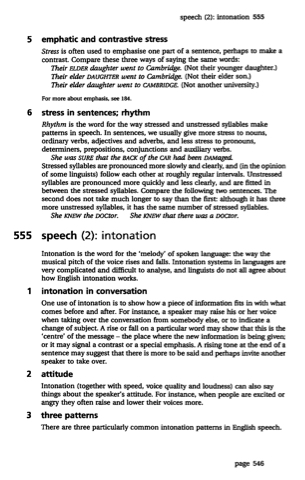Page 578 - Practical English Usage 3ed - Michael Swan, Oxford
P. 578
555
1
5
emphatic and contrastive stress
Stress is often used to emphasise one part of a sentence, perhaps to make a contrast. Compare these three ways of saying the same words:
Their ELDER daughter went to Cambridge. (Not their younger daughter.) Their elder DAUGHTER went to Cambridge. (Not their elder son.)
Their elder daughter went to CAMBRIDGE. (Not another university.)
For more about emphasis. see 184. stress in sentences; rhythm
Rhythm is the word for the way stressed and unstressed syllables make patterns in speech. In sentences, we usually give more stress to nouns, ordinary verbs, adjectives and adverbs, and less stress to pronouns, determiners, prepositions, conjunctions and auxiliary verbs.
She was SURE that the BACK of the CAR had been DAMaged.
Stressed syllables are pronounced more slowly and clearly, and (in the opinion of some linguists) follow each other at roughly regular intervals. Unstressed syllables are pronounced more quickly and less clearly, and are fitted in between the stressed syllables. Compare the following two sentences. The second does not take much longer to say than the first: although it has three more unstressed syllables, it has the same number of stressed syllables.
She KNEW the DOCtor. She KNEW that there was a DOCtor.
speech (2): intonation
Intonation is the word for the 'melody' of spoken language: the way the musical pitch of the voice rises and falls. Intonation systems in languages are very complicated and difficult to analyse, and linguists do not all agree about how English intonation works.
intonation in conversation
One use of intonation is to show how a piece of information fits in with what comes before and after. For instance, a speaker may raise his or her voice when taking over the conversation from somebody else, or to indicate a change of subject. A rise or fall on a particular word may show that this is the 'centre' of the message - the place where the new information is being given; or it may signal a contrast or a special emphasis. A rising tone at the end of a sentence may suggest that there is more to be said and perhaps invite another speaker to take over.
attitude
Intonation (together with speed, voice quality and loudness) can also say things about the speaker's attitude. For instance, when people are excited or angry they often raise and lower their voices more.
three patterns
There are three particularly common intonation patterns in English speech.
6
2
3
speech (2): intonation 555
page 546


